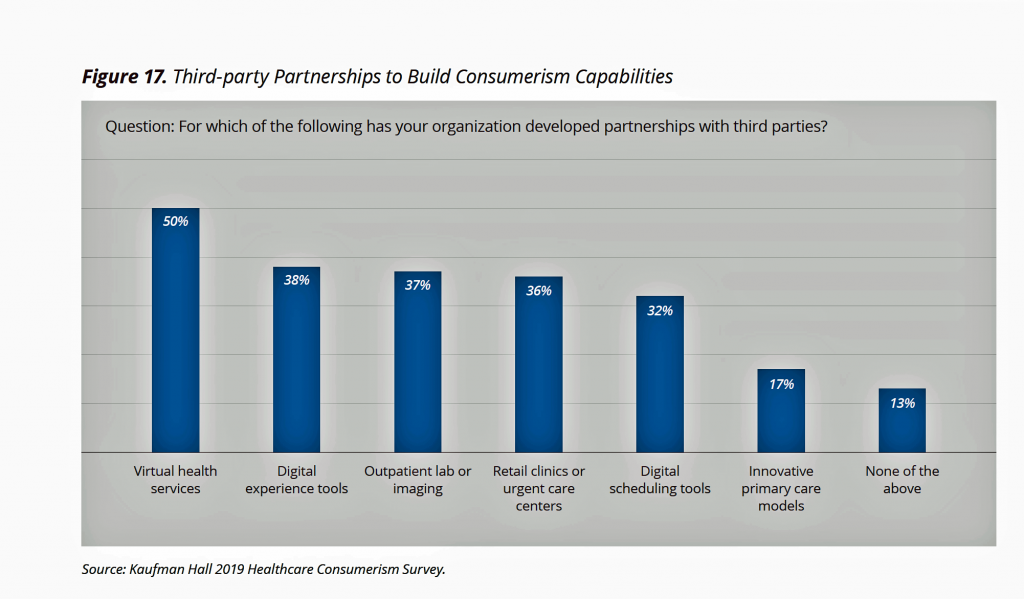Most U.S. healthcare providers are spending more time, effort and capital with an eye to engaging with patients-as-consumers, a trend quantified in the report, the 2019 State of Consumerism in Healthcare: The Bar is Rising from Kaufman Hall, summarizing results from this year’s healthcare consumerism index survey conducted among about 200 healthcare providers.
 “Legacy organizations will need premier-level consumer capabilities to compete in today’s increasingly consumer-centric environment,” Kaufman Hall recommends. Providers identified the key capability gaps for consumer-centric care as improving the consumer experience, offering a variety of facility-based access points, utilizing digital tools for health engagement, providing price transparency, and offering more virtual access points.
“Legacy organizations will need premier-level consumer capabilities to compete in today’s increasingly consumer-centric environment,” Kaufman Hall recommends. Providers identified the key capability gaps for consumer-centric care as improving the consumer experience, offering a variety of facility-based access points, utilizing digital tools for health engagement, providing price transparency, and offering more virtual access points.
Those highest-threat “premier-level” consumer health service organizations would be UnitedHealth Group/Optum. CVS Health/Aetna, Amazon, Google/Alphabet, and Apple, in the Kaufman Hall poll.
The most prevalent convenient access points providers offer are walk-in clinic hours, “save-a-spot” urgent care, and same-day appointments, with online schedule, evening and weekend clinic hours, and online-self scheduling for new patients falling behind.

As consumers go digital to project manage many daily activities, they look to do more personal health work flows this way, too, especially via mobile platforms. The second chart illustrates that most providers offer a patient portal — that’s largely owing to the near-universal adoption of electronic health records and the Meaningful Use access point of a portal. A distant second digital tool for health consumer engagement is smartphone apps, available by one in three providers. In-home monitoring and wearable devices are offered by about one in ten healthcare providers. And voice, while currently hyped in trade and mass media, has virtually nil availability yet in real-world healthcare delivery.
A key on-ramp to providers building capabilities to meet consumers’ service demands is by working with third parties who have the competence, experience, and oftentimes brand recognition that can turbocharge tech or new service adoption.
 The most popular consumer-facing health service where providers are collaborating with third parties are virtual health services (think telehealth vendors like American Well or Teladoc), digital experience tools (like Welltok or Salesforce), outpatient lab (e.g., Quest or LabCorp), and retail or urgent care (such as CVS/Minute Clinic or Walmart).
The most popular consumer-facing health service where providers are collaborating with third parties are virtual health services (think telehealth vendors like American Well or Teladoc), digital experience tools (like Welltok or Salesforce), outpatient lab (e.g., Quest or LabCorp), and retail or urgent care (such as CVS/Minute Clinic or Walmart).
Ultimately, building capacity for delivering on the promise of consumer experiences will compel providers to adopt a hospital mindset to “delight,” not just satisfy, Kaufman Hall urges. This means addressing the entire continuum of the patient/consumer journey across all touchpoints, leveraging platforms that consumers already use to live, work, play and learn.
 Health Populi’s Hot Points: Speaking of learning, Kaufman Hall’s 2019 report is well-timed to coincide with my attendance at the Disney Institute’s Women’s Leadership Summit this week in Orlando — that happiest place on earth. I’ll be trend-weaving the learnings of the best practices in hospitality for health/care, and I’m in good company here sharing perspectives with many health/care industry leaders.
Health Populi’s Hot Points: Speaking of learning, Kaufman Hall’s 2019 report is well-timed to coincide with my attendance at the Disney Institute’s Women’s Leadership Summit this week in Orlando — that happiest place on earth. I’ll be trend-weaving the learnings of the best practices in hospitality for health/care, and I’m in good company here sharing perspectives with many health/care industry leaders.
We’re brainstorming the consumer experience in health care for three days, and I’ll be sharing with Health Populi readers the best thinking coming out of this experience. Stay tuned for a post on Friday 7th June for those insights…





 I was invited to be a Judge for the upcoming
I was invited to be a Judge for the upcoming  Thank you Team Roche for inviting me to brainstorm patients as health citizens, consumers, payers, and voters
Thank you Team Roche for inviting me to brainstorm patients as health citizens, consumers, payers, and voters  For the past 15 years,
For the past 15 years,